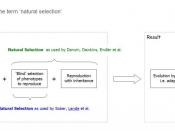Convergent evolution is the process that makes species develop similarly, although independently of each other, as a result of having similar ecological roles and selection pressure. This gives credibility to the idea of "natural selection": greater reproductive success of different phenotypes resulting from the interaction of organisms with their environment. Convergent evolution shows that natural selection is a strong driving force of change. Due to the similarities in environments and external stimuli, species adapt similarly in order to function more efficiently. Natural selection is important in the process of convergent evolution because it shows that change consistently depends on a common factor, the environment.
Convergent evolution takes place with different species in different locations with similar ecological conditions and selection pressures. Why is there a similarity in structure and development of these non-ancestrally-related species? The common factor between these distant species is the environment. External environmental factors drive functional adaptation: they encourage specific genes to succeed, reproduce and evolve.
The similar adaptations that species have to develop can give rise, for example, to similar skeletons that are most beneficial for certain terrain. These similarities between individuals, and their separate adaptations due to natural selection, support the theory that convergent evolution drives functional adaptation.
Specific examples of convergent evolution can be found when comparing the Giant Armadillo (North America), the Giant Pangolin (Africa), the Giant Anteater (South America) and the Spiny Anteater (Oceania). They all have similar structure and function due to their functional adaptation to the environment, yet come from completely different ancestral genes. For example, the common structure of their long pointed noses has evolved to better equip them for eating small insects in trees. Studies show no common link of ancestry; therefore these changes have occurred independently through natural selection. This evidence supports the idea that...


